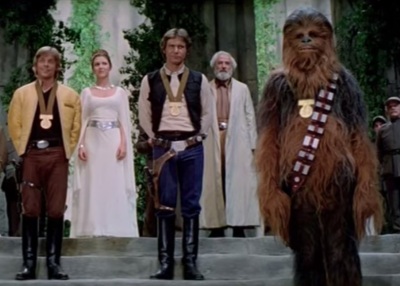Category: Movie Novelizations
Review – “Return of the Jedi” – Novelization (1983)
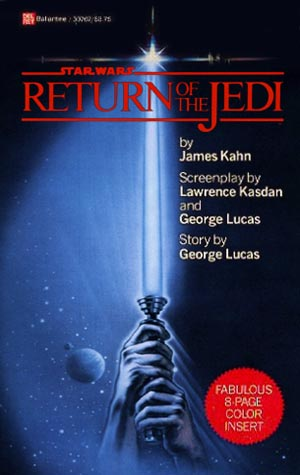 “The Rebel fleet has gathered all its forces into a single giant armada. The time is at hand when we can crush them, without mercy, in a single blow.” – Darth Vader
“The Rebel fleet has gathered all its forces into a single giant armada. The time is at hand when we can crush them, without mercy, in a single blow.” – Darth Vader
Two weeks before Return of the Jedi premiered in theaters, it was released as a novel written by James Kahn. Can you imagine having read the final chapter of the Star Wars trilogy before actually having seen the movie? I guess some people did that. What a strange thought. This novel is Kahn’s first and only contribution to the Star Wars universe.
Being a novelization of the movie, this book is pretty much what you’d expect. It’s the same story, and there isn’t much added to it. What little extra bits of information the book does give us are pretty great though, and they really made this novelization worth reading.
One thing I noticed right off the bat when I started reading was that I really liked Kahn’s writing style. I’m afraid I can’t really describe what exactly I liked about it. There’s just something about it that intrigued me and held my interest even though I already knew the entire story I was reading.
A few scenes that were deleted from the movie still appear in this book, to my delight. Most notably, we get to see Luke building his new lightsaber at the beginning of the story. It doesn’t flat-out say “Luke is building a lightsaber” but, he totally is. He assembles his lightsaber in a cave, and gives it to Artoo. Then, like in the movie, R2-D2 and C-3PO make their way off to Jabba the Hutt’s palace.
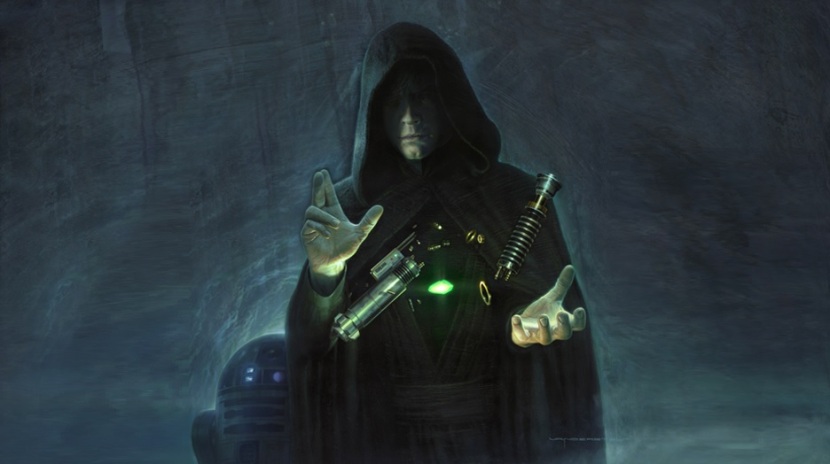
Speaking of Jabba, this book is, to my knowledge, the first time “Hutt” was ever spelled with two T’s instead of one. And, finally, he appears as we know him from the movies. He’s a big ol’ giant ol’ ugly ol’ slug. Not a human. Not a… yellow… guy… He’s normal Jabba the Hutt. However, when describing Jabba in the first chapter of the book, Kahn writes: “He had no hair–it had fallen out from a combination of diseases.” So, apparently, Jabba the Hutt had hair once. I can’t picture him looking anything but ridiculous with hair on his head, which is why I kind of love this random detail.
For me, the best parts of the book were parts where we got to get into the heads of the characters a little more. Through the narration we get to know and understand the characters better than we do in the film. For example, it is pretty obvious right away that Leia is in-tune with the Force (though she doesn’t know it), as there are many times throughout the entire story where she connects with the Force unknowingly. These are things that cannot be shown in a movie. We only learn about them through reading.
Another thing that this book did great that the film couldn’t do was describe to us Luke’s struggle with the dark side of the Force. The dark side is really starting to creep into Luke’s life here, and not just at the end of the book during his confrontation with Vader and the Emperor, but there are hints of darkness from the very beginning. Here’s an example:
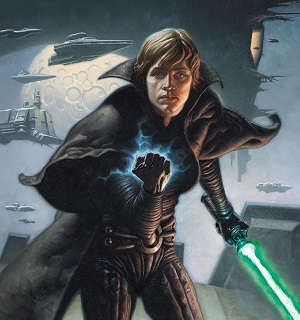 “[Luke] found Jabba despicable–a leech of the galaxy, sucking the life from whatever he touched. Luke wanted to burn the villain, and so was actually rather glad Jabba had refused to bargain–for now Luke would get his wish precisely. Of course, his primary objective was to free his friends, whom he loved dearly; it was this concern that guided him now, above all else. But in the process, to free the universe from this gangster slug–this was a prospect that tinted Luke’s purpose with an ever-so-slightly dark satisfaction.”
“[Luke] found Jabba despicable–a leech of the galaxy, sucking the life from whatever he touched. Luke wanted to burn the villain, and so was actually rather glad Jabba had refused to bargain–for now Luke would get his wish precisely. Of course, his primary objective was to free his friends, whom he loved dearly; it was this concern that guided him now, above all else. But in the process, to free the universe from this gangster slug–this was a prospect that tinted Luke’s purpose with an ever-so-slightly dark satisfaction.”
And then, a few pages later:
“The deck gunners were lining up . . . their shots for the coup de grace, when Luke stepped in front of them, laughing like a pirate king. He lit his lightsaber before they could squeeze off a shot; a moment later they were smoking corpses.”
Though still the clear hero and protagonist of the story, darkness is beginning to overtake the light, and Luke is enjoying it. Towards the end of the story this becomes much worse, as we realize how close Luke almost came to actually turning to the dark side while in the Emperor’s presence, like his father did at the end of the Clone War. “In this bleak and livid moment, the dark side was much with him.”
In the Expanded Universe, in a comic series set a few years after Return of the Jedi called Dark Empire, Luke actually does fall to the dark side for a short time before turning back to the light. I guess his struggle wasn’t over after the Death Star blew up.
This novelization includes another deleted scene from the movie of when Luke, Han, Leia, Lando, Chewbacca, R2-D2, and C-3PO are all walking back from Jabba’s palace to their ships through a sandstorm (and in the words of nine-year-old Anakin Skywalker: “Sandstorms are very, very dangerous!”). It doesn’t add much to the story, and it’s easy to see why it was cut from the movie, but it did offer some great moments and good dialogue. It was a welcome addition to the book for sure.
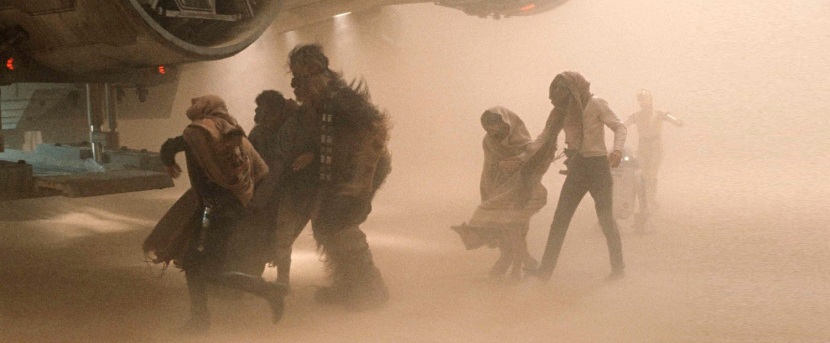
Many moments are expanded upon and leave us with some great new insights about the story. Early on in the book we learn more about Darth Vader’s desire to kill Emperor Palpatine and rule the galaxy in his stead, with his son at his side.
We learn that Obi-wan never told Luke about his real father because Yoda forbade him from revealing the truth to him.
When Obi-wan appears to Luke, he says “If I was wrong in what I did, it certainly wouldn’t have been for the first time. You see, what happened to your father was my fault.” Obi-wan blames himself for Anakin’s fall to the dark side. Like in the movie, Obi-wan tells Luke that he believed he could train Anakin as well as Master Yoda. He then says “My pride had terrible consequences for the galaxy.”
He regrets training Anakin. He was told not to train Anakin in The Phantom Menace, but he still did, against his own better judgment, because he promised Qui-Gon that he would. He trained the boy anyway, taught him about the Force and how to be a Jedi knight, and then Anakin became a Sith Lord. Obi-wan thinks this is all his fault. Man, he’s being pretty hard on himself.
The scene goes on, and it is one of my favorite scenes in the novel, because Obi-wan tells Luke more about Anakin than what he told in the movie:
You should not think of that machine as your father. When I saw what had become of him, I tried to dissuade him, to draw him back from the dark side. We fought . . . your father fell into a molten pit. When your father clawed his way out of that fiery pool, the change had been burned into him forever–he was Darth Vader, without a trace of Anakin Skywalker. Irredeemably dark. Scarred. Kept alive by machinery and his own black will . . .
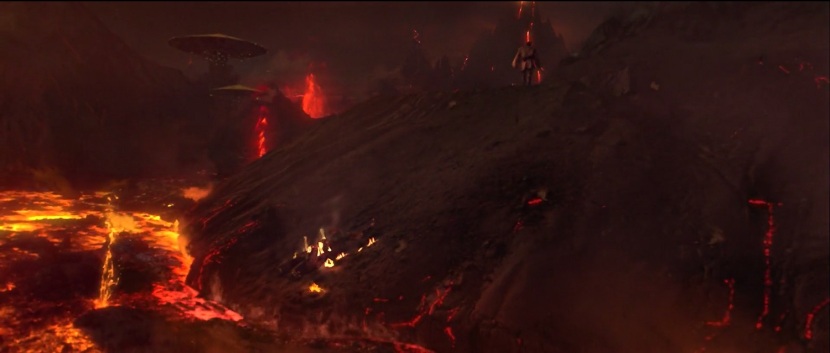
Sound familiar? Like how the novelization of A New Hope basically summarized the entire prequel trilogy in its prologue, this novelization of Return of the Jedi once again shows us just how much of the prequel trilogy George Lucas already had in mind when making the original trilogy. It’s pretty fascinating to me. And reading this really made the two trilogies feel more connected. Having old Ben Kenobi describe a scene to Luke from Revenge of the Sith is kind of awesome, especially since the book came out more than 20 years before Revenge of the Sith premiered in theaters.
One of my favorite things about reading these old novelizations of the original Star Wars trilogy is trying to pick out the differences between the films and the novels. Luke flew in Blue Squadron in the A New Hope novelization, Yoda was blue in The Empire Strikes Back novelization. Something had to be blue in this book that wasn’t blue in the movies, right?
Sadly, no.
But there were still a bunch of things that didn’t quite match up with what we see in the movie.
I’m gonna jump right to the biggest, most well-known difference: Obi-wan Kenobi and Owen Lars are brothers. Uncle Owen is Obi-wan’s brother, instead of Anakin’s stepbrother. There’s not much else to say about this. Obi-wan simply says “I took you to live with my brother Owen, on Tatooine.” That’s all that is said about it. Obi-wan and Owen are brothers in this version of the story.
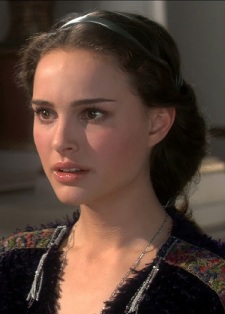 Which leads into the next big difference that I noticed: not only does Leia remember her mother, but Luke does too. Luke and Leia both somehow remember Padmé even though she was only alive for like the first five minutes of their lives. Apparently Padmé lived for much longer in this version of the story. When Obi-wan appears to Luke on Dagobah, he tells Luke a little about his mother. He says “When your father left, he didn’t know your mother was pregnant. Your mother and I knew he would find out eventually, but we wanted to keep you both as safe as possible, for as long as possible. So I took you to live with my brother Owen, on Tatooine . . . and your mother took Leia to live as the daughter of Senator Organa, on Alderaan.” Leia has many memories of her real mother. In this book it makes more sense than it does in the movies, now that we’ve seen the prequels.
Which leads into the next big difference that I noticed: not only does Leia remember her mother, but Luke does too. Luke and Leia both somehow remember Padmé even though she was only alive for like the first five minutes of their lives. Apparently Padmé lived for much longer in this version of the story. When Obi-wan appears to Luke on Dagobah, he tells Luke a little about his mother. He says “When your father left, he didn’t know your mother was pregnant. Your mother and I knew he would find out eventually, but we wanted to keep you both as safe as possible, for as long as possible. So I took you to live with my brother Owen, on Tatooine . . . and your mother took Leia to live as the daughter of Senator Organa, on Alderaan.” Leia has many memories of her real mother. In this book it makes more sense than it does in the movies, now that we’ve seen the prequels.
One thing I praised the novelization of The Empire Strikes Back for was how it depicted Vader’s relationship with the Emperor. In that book, Darth Vader was terrified of Emperor Palpatine. I loved that detail and hoped to see it expanded upon in this book. But, Vader doesn’t seem afraid of Palpatine in the slightest in this novelization. He respects him, but it doesn’t seem like he fears him. Though this is more true to the movies, I was hoping it would be different. I liked the idea that Darth Vader lived in constant fear of his Master.
During the confrontation between Luke and Vader on the Death Star, Luke tells Vader “You could not bring yourself to kill me before–and you won’t destroy me now.” This happens in the movie. It is a line most people would be familiar with. What is different, however, is that afterward the author goes to write “Twice before, in fact–to Luke’s recollection–Vader could have killed him, but didn’t. In the dogfight over the first Death Star, and later in the lightsaber duel on Bespin.” Seems accurate, right? Well, this one line shows that the Star Wars Expanded Universe was still not being acknowledged by official media at this point. If we take the Star Wars Expanded Universe into consideration, there was a third confrontation where Vader did not kill Luke in a duel on the planet Mimban, in the book Splinter of the Mind’s Eye.
Another thing that stuck out to me while reading was that the name “Palpatine” was used many times in this book, both in the narration, and in character dialogue. Despite the name also appearing in the novelization of A New Hope, the Emperor’s name is never once uttered in any of the three movies in the original Star Wars trilogy. For this reason, little-kid-me who was young Ani Skywalker’s age when The Phantom Menace was released had no idea that Senator Palpatine was the man who would become the Emperor. I don’t think I knew this until the trailer for Revenge of the Sith made it clear. Now it seems so obvious, but I was a kid at the time and the name “Palpatine” meant nothing to me. I find it interesting how often his name was used in this book.
I could keep going on, and mention every little thing I liked about this book, and talk about every little detail that I found interesting. I think I’ve already done that enough. But, I do want to say that my favorite part of the entire book is at the end, after Vader threw the Emperor to his death, when he asks Luke to take his mask off. This scene was written so beautifully, and was really enhanced by allowing us to get inside Anakin Skywalker’s head as he looks at his son for the first time with his own eyes.
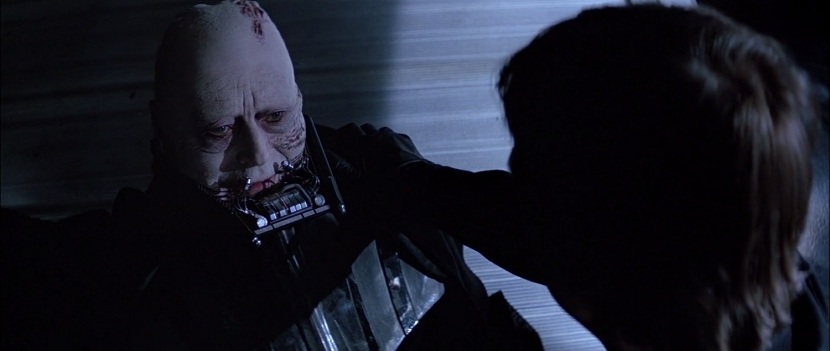
Tears fall down Luke’s face when he see’s his father’s real face for the first time. Anakin feels very self-conscious, and thinks Luke is crying in horror at the sight of his horribly scarred and sickly pale appearance. His mind starts to wander. He remembers what he used to look like: “striking, and grand, with a wry tilt to his brow that hinted of invincibility and took in all of life with a wink. Yes, that was how he looked once.” Ah, yes, just like Hayden Christensen!
These memories lead to more memories. Anakin thinks back to his time as a Jedi. He thinks about Padmé, and he thinks about Obi-wan. Then, he thinks about molten lava crawling up his back, and at that moment he stops, not allowing himself to think of such terrible things.
Anakin looks back up at Luke, and the scene is described like this:
“The boy was good, and the boy had come from him–so there must have been good in him, too. He smiled up again at his son, and for the first time, loved him. And for the first time in many long years, loved himself again, as well.”
Still believing that look is disgusted by his physical appearance, Anakin echos the words of Yoda, saying “Luminous beings are we, Luke–not this crude matter.”
The rest of the scene plays out like it does in the movie. But these extra details really made this scene so much more powerful. Knowing exactly what Anakin was thinking in these last moments of his life, knowing the memories that were coming to his mind and the emotions that he was feeling before he died made reading this small section of the novel a real treat. These are things we can’t be shown on film, and it is one of the rare moments where the novel really outshines the movie.
For whatever reason, I really enjoyed this novelization. I complained that the novelization of Empire Strikes Back didn’t really add anything new to the story, and this novel is guilty of the same thing in most instances, but there’s something about Kahn’s writing style that did a great job of pulling me in, even though I already knew the story. That, combined with the moments I’ve pointed out that let us get into the heads of the characters, which are the few moments that do provide us with extra details that the movies do not, makes for a genuinely entertaining read.
If you’re really just interested in getting “new” information, then this review is probably all you need to read, but if you’re just looking for a well-written novelization of a movie you like, then yes, definitely read this one. I certainly enjoyed it.
Score: 7.5/10
Review – “The Empire Strikes Back” – Novelization (1980)
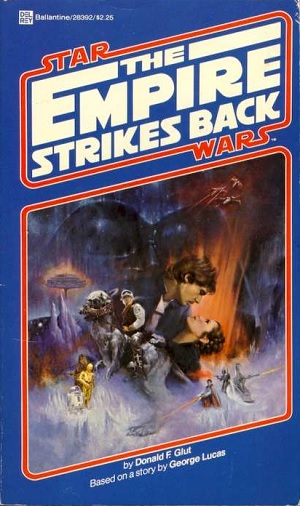 “You are the last Jedi, Luke. You are our only hope. Be patient.” – Ben Kenobi
“You are the last Jedi, Luke. You are our only hope. Be patient.” – Ben Kenobi
The novelization of The Empire Strikes Back was released April 12, 1980, a month before the film itself came out in theaters. The novelizations of the first six Star Wars films all came out before the films themselves did, though it looks like that trend has stopped, as last year’s The Force Awakens novelization was released the same day as the movie. Though it is the second movie novelization, it is the fifth Star Wars novel to be released, after the novelization of the first movie, Splinter of the Mind’s Eye, Han Solo at Stars’ End, and Han Solo’s Revenge. The final book in Brian Daley’s Han Solo trilogy, Han Solo and the Lost Legacy, was released four months after this. The Star Wars Expanded Universe was young, but growing.
This one was written by Donald F. Glut, and it is the only Star Wars novel he ever wrote, though he had previously written some issues of Marvel’s Star Wars comic series.
There’s not a whole lot to say about this one. It’s good. Not great. Not bad. Good. It is written well. No complaints with the writing style, or choice of words or anything like that. It’s just that there’s not much more to the novel than what we see in the movie. Like The Force Awakens novelization, this one is pretty much a straight retelling of what we see on-screen in the movie itself. There are, however, a few differences between the book and the movie. Nothing major, but it was fun to try picking all the differences out. For one, C-3PO is fluent in ten times more forms of communication than in the movies! “I’m fluent in over sixty million forms of communication!” Wow. What an upgrade!
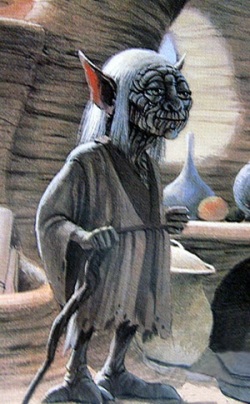 One of the more obvious differences was the physical description of Yoda. From what I understand, Yoda’s appearance was kept tight under wraps even from those who were working on the novelization and comic book adaptations of the movie, so the Yoda we meet in the book isn’t quite the same Yoda we see on-screen. The book describes Yoda as a being whose “long white hair was parted down the middle and hung down on either side of the blue-skinned head. The being was bipedal, and stood on short legs that terminated in tridactyl, almost reptilian feet.” He was also described as having “bulbous eyes.” Though not drastically different than the green-skinned creature we know so well, it is still different enough to be noteworthy. Shortly after meeting Yoda, we get a fun peek inside Luke’s head as he thinks to himself “How could an elf like this know anything about a great teacher of the Jedi Knights?”
One of the more obvious differences was the physical description of Yoda. From what I understand, Yoda’s appearance was kept tight under wraps even from those who were working on the novelization and comic book adaptations of the movie, so the Yoda we meet in the book isn’t quite the same Yoda we see on-screen. The book describes Yoda as a being whose “long white hair was parted down the middle and hung down on either side of the blue-skinned head. The being was bipedal, and stood on short legs that terminated in tridactyl, almost reptilian feet.” He was also described as having “bulbous eyes.” Though not drastically different than the green-skinned creature we know so well, it is still different enough to be noteworthy. Shortly after meeting Yoda, we get a fun peek inside Luke’s head as he thinks to himself “How could an elf like this know anything about a great teacher of the Jedi Knights?”
Luke’s training with Yoda is also expanded upon. We get to see more of Luke training, and we get to hear more of Yoda’s wisdom and teachings. These were some of my favorite parts of the novel, because they were some of the only “extra” scenes the book provided that the movie didn’t have. We get to see Luke actually training in lightsaber combat, which was fun. Yoda also has Luke make them dinner, and while Luke is busy trying to cook in Yoda’s tiny kitchen, Yoda ambushes him with training droids. It is fun to see this stuff, and it makes Luke’s training feel more real, because we hardly see any of it in the actual movie. The narrator tells us that “Yoda spent long hours lecturing his student about the ways of the Jedi. As they sat under the trees near Yoda’s little house, Luke listened intently to all the master’s tales and lessons.”
The Dagobah cave scene is also expanded upon slightly, and like in Alan Dean Foster’s novelization of the first Star Wars movie, Darth Vader is wielding a blue lightsaber. I’m not sure when it was officially made clear that his sword is supposed to be red. Today it is obvious to everyone that he has a red sword, but back then the coloring of the lightsabers was so bad that they all just looked white.
In the beginning of the book, after Luke is rescued from the wampa and put in the bacta tank, he starts mumbling to himself in his unconscious state. He says “Yoda . . . Go to Yoda.” Han and Chewbacca are in the room and the narrator points out that neither one of them has any idea what Luke is talking about. Uhh… Chewbacca would totally know what Luke is talking about. We all know that Chewie and Yoda were buddies 25 years back. Stupid narrator, unable to predict future pointless movie twists! It actually makes me wonder how the story would have turned out differently if Luke would have mentioned Yoda to Chewie, given what we now know about their past.
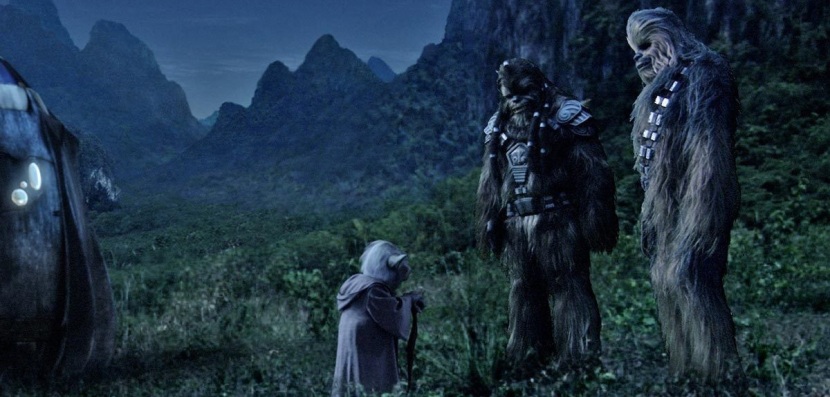
One thing that caught my attention was during the Battle of Hoth. There was a moment right before Luke and Han went separate ways where the author writes “The two friends, Luke and Han, stood looking at each other, perhaps for the last time.” This was interesting to me because I just recently read The Force Awakens novelization, where the author wrote similar things about Han and Leia, and Han and Chewbacca. The book made it much more obvious than the movie did that Han was saying goodbye to Leia and Chewie for the last time in both instances. Of course, here in The Empire Strikes Back, Han and Luke do get to see each other again. I just found it interesting because The Force Awakens novelization had two nearly identical moments, though in both cases, it really was the last time Han would see those characters.
There were moments of the book that left me wanting to know more. When Boba Fett makes an appearance we are told that “He was dressed in a weapon-covered, armored spacesuit, the kind worn by a group of evil warriors defeated by the Jedi Knights during the Clone Wars.” What? I want to hear more about that Clone Wars battle! Fett is wearing traditional Mandalorian armor, but I’ve watched all six seasons of The Clone Wars TV series, and the two seasons of the earlier 2d Clone Wars show, and I never got to see the Jedi Knights defeat a group of evil Mandalorian warriors. Somebody, make this story happen!
The Empire Strikes Back is the first time we ever get to see Emperor Palpatine. The prologue of the novelization of A New Hope does mention him, but other than that, this is Palpatine’s first appearance in Star Wars. One thing I loved about the Emperor in this novel is that Donald F. Glut really made the Emperor seem terrifying. Possibly my favorite parts of the entire book were just the descriptions of the Emperor. Here is an example:
Only one being in the entire universe could instill fear in the dark spirit of Darth Vader. As he stood, silent and alone in his dim chamber, the Dark Lord of the Sith waited for a visit from his own dreaded master.
As he waited, his Imperial Star Destroyer floated through a vast ocean of stars. No one on his ship would have dared disturb Darth Vader in his private cubicle. But if they had, they might have detected a slight trembling in that black-cloaked frame. And there might even have been a hint of terror to be seen upon his visage, had anyone been able to see through his concealing black breath mask.
. . .
The Emperor’s presence was awesome enough, but the sound of his voice sent a thrill of terror coursing through Vader’s powerful frame.
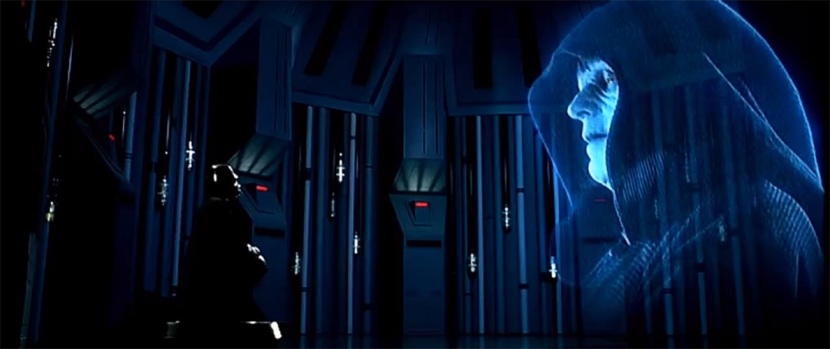
Even Darth Vader is terrified of Emperor Palpatine in this adaptation. I love this. The Emperor didn’t seem all that scary in the movie, but in this book you realize just how frightening the man really is. With all the backstory we now have about Palpatine and Anakin, it makes this description even more disturbing. Anakin and Palpatine were friends at one point. Now Anakin serves Palpatine, and he is terrified of him. Vader isn’t completely fearless. His own master is his worst nightmare.
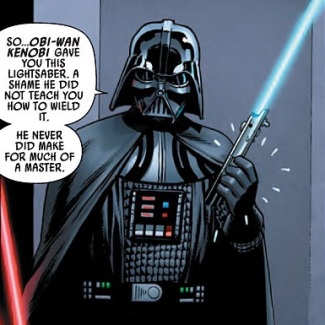 It is interesting to note that when Luke fights Vader in Cloud City, it is not the first time they have fought in either the Legends continuity or in the new canon. In Legends, Luke first fights Vader in Splinter of the Mind’s Eye on the planet Circarpous V (also known as “Mimban”). In the new canon, Luke fights Vader (or at least attempts to) in the second issue of Marvel’s rebooted Star Wars comic book series. In the comic version, this is where Vader realizes that Luke is carrying his old lightsaber, and after learning from Boba Fett that Luke’s name is “Skywalker” he puts the pieces together and realizes exactly who Luke is; his son. In any case, Vader and Luke’s confrontation in The Empire Strikes Back is not their first confrontation in any version of Star Wars continuity at this point.
It is interesting to note that when Luke fights Vader in Cloud City, it is not the first time they have fought in either the Legends continuity or in the new canon. In Legends, Luke first fights Vader in Splinter of the Mind’s Eye on the planet Circarpous V (also known as “Mimban”). In the new canon, Luke fights Vader (or at least attempts to) in the second issue of Marvel’s rebooted Star Wars comic book series. In the comic version, this is where Vader realizes that Luke is carrying his old lightsaber, and after learning from Boba Fett that Luke’s name is “Skywalker” he puts the pieces together and realizes exactly who Luke is; his son. In any case, Vader and Luke’s confrontation in The Empire Strikes Back is not their first confrontation in any version of Star Wars continuity at this point.
This book was an entertaining read, but like I said before, there isn’t much to it. I mentioned my main points of interest already in this review. I enjoyed the book, but will probably never read it again. There just isn’t a reason to come back to it. On the other hand, The Empire Strikes Back is my favorite movie of all time. I could watch it a thousand times and still love it. I’d say stick with the movie for this one, unless of course you’re like me and you just want to read everything Star Wars.
I’ll end this review with one of the more jarring differences between the book and the movie. The famous lines “I love you” “I know” are not uttered in this novelization. Instead, when Han is about to be dropped into the carbon freezing chamber, Leia says to him “I love you . . . I couldn’t tell you before, but it’s true.”
Han then replies, “Just remember that, because I’ll be back.”
Score: 6.5/10
Review – “The Force Awakens” – Novelization (2015)
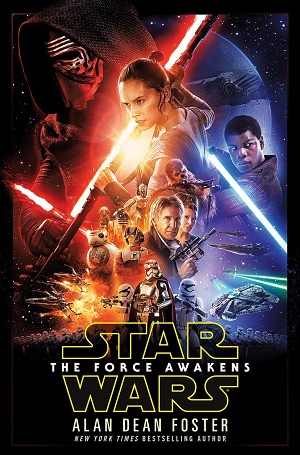 “The historians have it all wrong. It was neither poor strategy nor arrogance that brought down the Empire . . . [It was] such a simple thing. Such a foolish error of judgment. A momentary lapse in an otherwise exemplary life. Had Lord Vader not succumbed to emotion at the crucial moment–had the father killed the son–the Empire would have prevailed. And there would be no threat of Skywalker’s return today.” – Supreme Leader Snoke
“The historians have it all wrong. It was neither poor strategy nor arrogance that brought down the Empire . . . [It was] such a simple thing. Such a foolish error of judgment. A momentary lapse in an otherwise exemplary life. Had Lord Vader not succumbed to emotion at the crucial moment–had the father killed the son–the Empire would have prevailed. And there would be no threat of Skywalker’s return today.” – Supreme Leader Snoke
Warning: This review contains many SPOILERS for The Force Awakens movie. Proceed at your own risk. But if you haven’t seen it already, go see it now!
Before I get started I want to make this clear that I am writing about the novel The Force Awakens and not the movie. I may yet write my thoughts about the film itself in a later post, but for now I’m sticking to the books. If you’re looking for a movie review, it is not here. Now that that’s out of the way, here we go:
I loved Alan Dean Foster’s novelization of the original Star Wars movie, as well as his second Star Wars novel Splinter of the Mind’s Eye, and I was very excited to hear that he was coming back to write the novelization of Star Wars: Episode VII. I’ve come to expect a very high standard of Star Wars movie novelizations, especially after the last one, Matthew Stover’s novelization of Episode III: Revenge of the Sith, blew me out of the water.
In order to adequately explain how I feel about this novelization of The Force Awakens, I have to first briefly explain what the novelization of Revenge of the Sith was like.
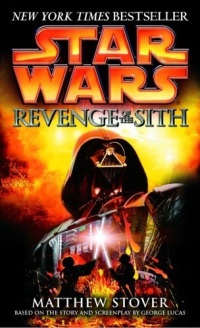 Stover’s Revenge of the Sith novelization was, in short, amazing. It might be the only time that a novelization of a Star Wars movie came close to actually surpassing the movie in terms of quality, content, and enjoyment. In fact, I have heard from many people who actually liked the book much more than the movie. The Revenge of the Sith novel had a luxury that The Force Awakens novel does not have: it had 35 years worth of Expanded Universe material to draw from to add to the story. With the recent canon reboot, and with next to zero stories existing near the time period of The Force Awakens, Foster simply couldn’t draw from decades of previously established stories to embellish the novelization with.
Stover’s Revenge of the Sith novelization was, in short, amazing. It might be the only time that a novelization of a Star Wars movie came close to actually surpassing the movie in terms of quality, content, and enjoyment. In fact, I have heard from many people who actually liked the book much more than the movie. The Revenge of the Sith novel had a luxury that The Force Awakens novel does not have: it had 35 years worth of Expanded Universe material to draw from to add to the story. With the recent canon reboot, and with next to zero stories existing near the time period of The Force Awakens, Foster simply couldn’t draw from decades of previously established stories to embellish the novelization with.
Stover’s Revenge of the Sith made many references to Expanded Universe (“Legends” now) stories and made them integral parts of the story of Episode III. Most notably, Stover drew from his own book Shatterpoint, which was a Clone Wars-era novel starring Mace Windu. Any scene featuring Mace Windu in Revenge of the Sith was made even better by acknowledging and drawing from Windu’s experiences and talents that we were introduced to in Shatterpoint. As a huge Expanded Universe fan, this made the novelization so much more enjoyable.
On top of that, Stover included brand new scenes that were not in the movie. Whether these scenes were his original creations, or if they were based on early scripts of the movie, I don’t know, and frankly, I don’t care. The fact is, the book contained new scenes and situations that I wasn’t familiar with, which greatly added to my enjoyment of the book.
Foster’s The Force Awakens novelization doesn’t really have any of that. Yes, it does have a few scenes that weren’t included in the movie (and those were probably my favorite parts of the entire book), but there weren’t many of them and the extra scenes weren’t very significant anyway. This novelization is more or less a direct scene-for-scene adaptation of what we all saw in the movie theater. I couldn’t help but ask myself “what’s the point of reading this when I can just watch the movie?” That’s not a question you should come away with while reading a book.
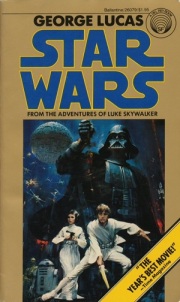 The book does have things I really liked. Right off the bat, before anything else, the novel opens with a short passage from the “Journal of the Whills.” It is a short verse that really isn’t all that important to read, but just the fact that it exists makes me happy. The Journal of the Whills dates back to some of the early drafts and concepts of the original Star Wars movie. It has never been expanded upon much, so we’ve never had a really good idea of what it is in the first place, but it seems to be almost like a book of scripture in-universe. The prologue in the novelization of A New Hope, which was one of my favorite parts of that entire book, was also a section of the Journal of the Whills. I was happy to see Foster revisit that idea and include it in his second novelization as well.
The book does have things I really liked. Right off the bat, before anything else, the novel opens with a short passage from the “Journal of the Whills.” It is a short verse that really isn’t all that important to read, but just the fact that it exists makes me happy. The Journal of the Whills dates back to some of the early drafts and concepts of the original Star Wars movie. It has never been expanded upon much, so we’ve never had a really good idea of what it is in the first place, but it seems to be almost like a book of scripture in-universe. The prologue in the novelization of A New Hope, which was one of my favorite parts of that entire book, was also a section of the Journal of the Whills. I was happy to see Foster revisit that idea and include it in his second novelization as well.
After the short verse from the Journal of the Whills we see the opening crawl of The Force Awakens on the next page. It is exactly the same as the crawl we read in the movie, word-for-word. And yes, I have seen the movie enough times already to confirm this. I know it to be true.
One of the cool things about the book is that the opening scene is completely different. We are not on Jakku. We are not seeing Poe, or BB-8. The novel instead opens with Leia. She desperately wants to know where Luke is, though she doesn’t even know if he is still alive. The Republic is on the verge of collapse, and she knows that her brother can be of help if she can ever find him.
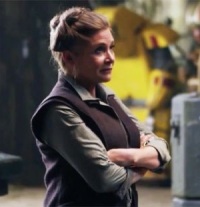 Leia isn’t introduced to us until pretty far into the movie. In the novel, we get to see her from the beginning, with short scenes here and there interspersed in between the scenes we are familiar with from the film. These scenes are cool, simply because they are new. They aren’t super important though, and I think Leia and Threepio’s introduction in the movie is actually better because we don’t see them from the beginning of the story. However, the scenes do provide a neat little bit of extra information for all the superfans out there like myself.
Leia isn’t introduced to us until pretty far into the movie. In the novel, we get to see her from the beginning, with short scenes here and there interspersed in between the scenes we are familiar with from the film. These scenes are cool, simply because they are new. They aren’t super important though, and I think Leia and Threepio’s introduction in the movie is actually better because we don’t see them from the beginning of the story. However, the scenes do provide a neat little bit of extra information for all the superfans out there like myself.
Chapter 2 is the actual first scene of the movie, on Jakku. Poe gets the piece of the map, Finn freaks out in his first mission, Phasma tells Finn to submit his blaster for inspection. One tiny detail I actually really appreciated, that maybe I was too stupid to understand when watching the movie, was that Phasma specifically asks Finn to submit his blaster because she thinks the reason he never fired it was because it was jammed. Maybe that was obvious to everyone else who watched the movie, but it wasn’t to me. It was a good little bit of clarification.
Highlights of the book include an extra scene of Poe on Jakku after his TIE Fighter crashes. It makes his later appearance in the story not seem so abrupt or confusing. Dialogue between Kylo Ren and Snoke is also expanded upon, which was really interesting to read. One of the main things is that it makes it very clear that Snoke and Kylo Ren are not unaware that Vader turned back to the light in Return of the Jedi. I’ve heard a lot of comments from people who are asking “Doesn’t Kylo Ren know that Vader turned good in the end?” Well, yes, Kylo does know that. So… There ya go.
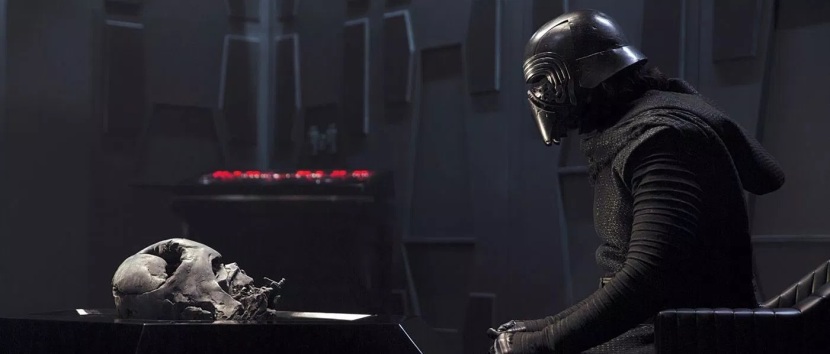
One thing that annoyed me was that the book points out that part of the map that BB-8 was carrying showed a well-known nebular cluster. If the map had well-known locations on it, then wouldn’t that be enough to get to the destination, even without the missing piece? In the movie, Threepio mentions that the map matches nothing on any of their records. But, apparently it shows a well-known landmark. Probably just a mistake, but it bothered me. Oh, by the way, the book makes it clear that it is not specifically a map to leads to Luke Skywalker (which would be stupid), but a map that leads to the first Jedi Temple, where people simply hope Luke Skywalker is. That makes way more sense.
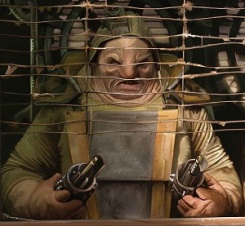 Unkar Plutt shows up later in the book, in Maz Kanata’s castle, and he’s angry at Rey for stealing the Millennium Falcon from him. This leads to a funny interaction between him and Chewbacca which I sort of wish had been in the actual movie, even though it really adds nothing to the story.
Unkar Plutt shows up later in the book, in Maz Kanata’s castle, and he’s angry at Rey for stealing the Millennium Falcon from him. This leads to a funny interaction between him and Chewbacca which I sort of wish had been in the actual movie, even though it really adds nothing to the story.
Another one of the things I really liked about the novel was that it explained how Starkiller Base’s weapon worked. A common complaint I’ve seen from fans about the weapon is that it makes no sense how its beam traveled across the galaxy so fast. The book actually goes into pretty good detail explaining why and how it can do that. Finn is actually the one who explains how it works to the Resistance:
“It doesn’t operate in what we’d call normal hyperspace. It fires through a hole in the continuum that it makes itself. Everybody was calling it ‘sub’-hyperspace. That’s how it can arrive in moments across a distance like that between the base and the Hosnian system . . . General Hux told us it’s the most powerful weapon ever built. He said that it can reach halfway across the galaxy . . . And in real time. Because it doesn’t reach across the galaxy; it reaches through it.”
I wasn’t really expecting an explanation for that, but I was happy to see it.
Another piece of info I appreciated was that this book confirms that Han and Leia are husband and wife. The movie never actually makes this clear. But they are in fact married. Didn’t have a kid out of wedlock or anything. Also, the book points out that when Han finally sees his son’s face it is the first time he has ever seen his son as an adult. How long has the kid been gone? A long time, apparently.
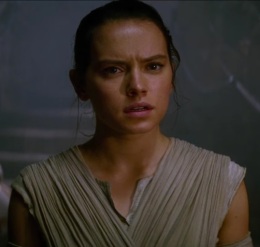 There was a short extra scene in which Kylo Ren actually boards the Millennium Falcon on Starkiller base. I was kind of hoping for a cool, emotional moment, with him remembering his past or something. But nothing really happens. It was sort of a letdown and I can see why it didn’t appear in the movie.
There was a short extra scene in which Kylo Ren actually boards the Millennium Falcon on Starkiller base. I was kind of hoping for a cool, emotional moment, with him remembering his past or something. But nothing really happens. It was sort of a letdown and I can see why it didn’t appear in the movie.
It is also strongly implied in the novel that Kylo Ren knows exactly who Rey is. After a display of her Force abilities, Kylo Ren turns to her and says “It is you.” After which the narrator adds “His words unsettled her: Not for the first time, he seemed to know more about her than she did herself.” While us in the audience can still do no more than speculate as to who Rey is, it seems safe to assume that at least one character in the film knows exactly who she really is. And the theories will continue to run wild.
One thing I really wanted an explanation for that I was really disappointed the novel didn’t clear up was this: why the heck did Artoo turn on when he did? Why didn’t he turn on when BB-8 first arrived? Why was his awakening so perfectly timed, right after the good guys had won their big battle? It felt incredibly cheap in the movie and I was hoping for an actual explanation for it in the book. There isn’t one. It is simply a deus ex machina that is never explained, and is incredibly lazy storytelling in my opinion.
Overall, I’d say this book is very skippable. There are some neat moments with extra tidbits of information, but not nearly enough that I’d really consider reading this book “worth it.” It is mostly a scene-for-scene direct adaptation of what we saw on-screen, with slightly longer dialogue. It is not written poorly, but it simply doesn’t provide enough new information for me to ever recommend this over the movie. While the novelization of Revenge of the Sith was filled to the brim with extra information and references to other Star Wars stories, The Force Awakens novelization is simply a prose version of the movie.
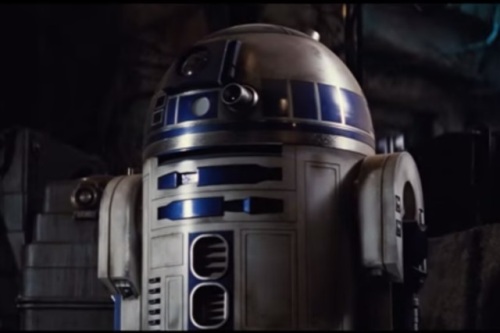
I am a fan of the movie (I’ve seen it five times already for crying out loud), though I have my fair share of criticisms about it. I had the biggest smile ever on my face the whole time when I saw the movie on opening night. And I had a slightly-less-big-but-still-there smile the other four times I saw it. However, when I left the theater after my first viewing I specifically remember thinking that if I had just experienced the exact same story in book form instead of as a movie, I would have thought it was stupid. Well, reading the book kind of validated that thought, and I honestly have to say that the book actually made me like the movie less, simply because it made it even more clear that the story is honestly not very good.
If you don’t care about extra information and simply want to read a book version of a movie you liked, then by all means read this book. If you’re like me and you were hoping for a little something extra, you’re likely going to be disappointed. Alan Dean Foster is a good author, but I really wish he would have been given some extra material to work with this time around. Honestly, I’d say you should skip this one.
Score: 5/10
Review – “Star Wars: From the Adventures of Luke Skywalker” (1976)
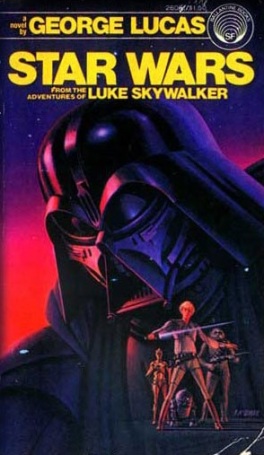 “I met your father once when I was just a boy, Luke. He was a great pilot. You’ll do all right out there. If you’ve got half your father’s skill, you’ll do a damn sight better than all right.” – Garven Dreis, “Blue Leader”
“I met your father once when I was just a boy, Luke. He was a great pilot. You’ll do all right out there. If you’ve got half your father’s skill, you’ll do a damn sight better than all right.” – Garven Dreis, “Blue Leader”
Star Wars: From the Adventures of Luke Skywalker, or Star Wars Episode IV: A New Hope, or just Star Wars. I don’t know what to call this book, because all of those titles are accurate. This is the novelization of the original Star Wars movie, and as such, it is the first Star Wars book ever written. After seeing The Force Awakens this past weekend (twice!) I thought it felt like a good time to look back on where this all started.
From the Adventures of Luke Skywalker was written by Alan Dean Foster and released in 1976, before Star Wars premiered in theaters. In later editions of the book George Lucas wrote a short introduction, and said this about it:
The world’s first glimpse of Star Wars happened with little fanfare, and this first edition of the novel sold modestly. It wasn’t until the official ‘tie-in’ version of the book that it sold millions of copies and broke records, much like the film was doing in theaters.
It was the first Star Wars book ever written, and the world’s first glimpse into the galaxy far, far away. Foster later wrote two other books in the Star Wars universe; Splinter of the Mind’s Eye was released two years later, and The Approaching Storm, was released 24 years after that. Foster just recently returened to the Star Wars universe as the author of the novelization of Star Wars Episode VII: The Force Awakens, which is currently only available as an eBook, but will see a physical release on January 5th. Though that book is a part of the “new Star Wars canon” and will not be considered a part of the Expanded Universe or “Legends” like his previous works were, I am excited that they chose an author who has already proven to be able to write good movie novelizations to write the new one too.
So, let’s get into this book. For this review (and every other review) I’m going to assume everyone has already seen episodes one through six of Star Wars. If you haven’t, I will be spoiling parts of multiple movies in this review (don’t worry, there is absolutely nothing about The Force Awakens in this review. You’re safe to continue). Since the book is a movie novelization I am going to spend a good chunk of the review comparing the book and the movie(s).
With that out of the way, let’s start from the beginning. The book opens with a short prologue that will feel very familiar to any Star Wars fan in 2015. The prologue is essentially a two-page summary of the events of the Star Wars Prequel Trilogy. It summarizes the extermination of the Jedi Knights and the fall of the Republic through the deception of Senator Palpatine and his rise to power as the galaxy’s first Emperor. It mentions how a small number of systems decided to rebel against the new Empire despite being vastly outnumbered. It tells you what happened in the past, and sets you right up for the story of Episode IV. Right off the bat this is one of my favorite parts of the entire book. Keep in mind that this book was released 23 years before The Phantom Menace came out, and almost 30 years before we saw Revenge of the Sith and saw Palpatine’s rise to power in live-action. In later editions of this book that include the introduction by George Lucas, he writes:
As this special hardcover edition of the original Star Wars novel goes to press, I am once again immersed in writing new episodes of the saga. It fills me with a sense of déjà vu, because the outline for the new trilogy of prequels is actually contained in the first two pages of this book, the prologue. I suppose I have come full circle as I return to the beginning and start again.
Today, having watched the events described in this prologue happen on-screen, I enjoy reading this even more. Strange to think that for the few people in the world who actually picked up this novel before Star Wars was first seen in theaters, their very first exposure to the universe we now know and love was actually a summary of the Star Wars prequels. The prologue to this book is actually enhanced by having watched the Prequel Trilogy, and I love it.
Chapter one starts exactly where the movie starts. The giant Star Destroyer is chasing down the hopeless rebel blockade runner. It’s an extremely familiar scene. You will have to get used to a few odd word-choices like ‘droids’ being referred to as ‘robots,’ the stolen Death Star plans constantly referred to as ‘tapes,’ and escape pods being referred to as ‘lifeboats’ among other things. This novel makes plenty of references to animals and things from Earth that feel a little weird, since later Star Wars books avoid this. The book mentions dogs, mice, peas, piranhas, dinosaurs, pandas, lemons, elephants, capybaras, baboons, pencils, and other things that feel out of place in a galaxy far, far away. Usually these things are only mentioned by the narrator. However, my favorite Earth-reference in the book comes out of Obi-Wan’s mouth on Tatooine. While explaining something to Luke in his desert hut, he casually says “even a duck has to be taught to swim.” To which Luke responds “what’s a duck?” Yeah, seriously, what is a duck?! How would anyone in Star Wars know what ducks are? I guess Naboo probably has some ducks. Obi-Wan has been there. I don’t know, I’m just making stuff up now. Getting back to the opening scene of the book, aside from the word choices that you will have to get used to, this is essentially the same scene we all know and love from the movie. And for the most part this book continues to remain faithful to the film throughout its entirety.
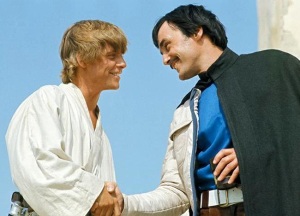 Chapter two is the exception to that rule, however. The second chapter introduces Luke Skywalker to us much earlier than the movie does, and we get a little peak at what life was like for him on Tatooine before C-3PO and R2-D2 show up and turn his world upside down. He’s pretty miserable, working on his uncle’s moisture farm, and very lonely, as most of his friends have left Tatooine to join the Imperial Academy, including his best friend, Biggs Darklighter. The people he now hangs around with don’t really respect him and don’t really seem to be his friends (as a side note, having just barely played through the video game Star Wars: Republic Commando, I found it interesting that one of these “friends” is named Fixer, a name shared by one of the Commandos of Delta Squad) and that probably contributes to why Luke wants to get away from Tatooine and join the Academy so badly. Biggs comes home and pays Luke a surprise visit, telling him that he is going to “jump ship” and join the rebellion. Luke is thrilled to see him, and you can tell that these two really are great friends. This makes Biggs’ appearance later in the book much more gratifying, and makes his death at the Battle of Yavin much sadder. This little glimpse into what Luke’s life was like before we meet him in the movie is another one of my favorite parts of the book, and most of it actually was filmed for the movie, but was eventually cut out for some reason.
Chapter two is the exception to that rule, however. The second chapter introduces Luke Skywalker to us much earlier than the movie does, and we get a little peak at what life was like for him on Tatooine before C-3PO and R2-D2 show up and turn his world upside down. He’s pretty miserable, working on his uncle’s moisture farm, and very lonely, as most of his friends have left Tatooine to join the Imperial Academy, including his best friend, Biggs Darklighter. The people he now hangs around with don’t really respect him and don’t really seem to be his friends (as a side note, having just barely played through the video game Star Wars: Republic Commando, I found it interesting that one of these “friends” is named Fixer, a name shared by one of the Commandos of Delta Squad) and that probably contributes to why Luke wants to get away from Tatooine and join the Academy so badly. Biggs comes home and pays Luke a surprise visit, telling him that he is going to “jump ship” and join the rebellion. Luke is thrilled to see him, and you can tell that these two really are great friends. This makes Biggs’ appearance later in the book much more gratifying, and makes his death at the Battle of Yavin much sadder. This little glimpse into what Luke’s life was like before we meet him in the movie is another one of my favorite parts of the book, and most of it actually was filmed for the movie, but was eventually cut out for some reason.
 Another deleted scene from the movie that appears in the book is the scene were Han Solo talks to Jabba the Hut (spelled with just one “T” in the book) outside his ship on Tatooine. This scene was included in the Special Editions of the movie, but in the book it happens as it was originally filmed: with Han speaking to the man Jabba. Jabba the Hutt is a human being in this scene. Personally, I love it in the Special Editions of the movie when Han says to the giant slug “you’re a wonderful human being.” It’s not as fun of a line when he actually is a human.
Another deleted scene from the movie that appears in the book is the scene were Han Solo talks to Jabba the Hut (spelled with just one “T” in the book) outside his ship on Tatooine. This scene was included in the Special Editions of the movie, but in the book it happens as it was originally filmed: with Han speaking to the man Jabba. Jabba the Hutt is a human being in this scene. Personally, I love it in the Special Editions of the movie when Han says to the giant slug “you’re a wonderful human being.” It’s not as fun of a line when he actually is a human.
The rest of the book follows the movie very closely. The only real differences are very minor things, like somebody saying a line slightly differently than the way they said it on-screen, or odd inconsistencies like people referring to R2-D2 as “Detoo” instead of “Artoo,” and C-3PO saying “our last master was captain Colton” instead of “captain Antilles.” Luke flies with Blue Squadron instead of Red Squadron. Obi-Wan smokes a pipe. Luke says “damn” a few times, which I found funny. Honestly, part of the fun of this book is trying to find everything that doesn’t quite match up with what we see in the movie. But none of the inconsistencies are so drastic that it negatively effects the story in any way, unless you’re obsessive about continuity.
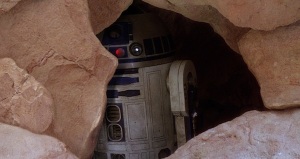 Many minor details in this book are actually enhanced by having watched the prequel trilogy, and, in some cases, are even enhanced by having watched the Special Editions of A New Hope. Some of the Special Edition changes that people love to complain about actually appeared in this novel first. In the Bluray release of this movie, Artoo hides from Tusken Raiders in a cave behind some giant rocks that were added in digitally that were not there in any previous versions of the movie. What a pointless change, right? Well, that’s actually how it is in the book. Artoo is hiding behind rocks here too. A very random thing to notice, but with all the outrage over the little changes made to the movie it was hard for me not to notice this detail in the book.
Many minor details in this book are actually enhanced by having watched the prequel trilogy, and, in some cases, are even enhanced by having watched the Special Editions of A New Hope. Some of the Special Edition changes that people love to complain about actually appeared in this novel first. In the Bluray release of this movie, Artoo hides from Tusken Raiders in a cave behind some giant rocks that were added in digitally that were not there in any previous versions of the movie. What a pointless change, right? Well, that’s actually how it is in the book. Artoo is hiding behind rocks here too. A very random thing to notice, but with all the outrage over the little changes made to the movie it was hard for me not to notice this detail in the book.
The scene where Obi-Wan tells Luke about his father and the Jedi of old is another one of the moments that is actually explored deeper in this book than in the movie, and for that reason it was another big highlight of the book for me. While speaking of the Jedi, Obi-Wan says “In many ways they were too good, too trusting for their own health. They put too much trust in the stability of the Republic, failing to realize that while the body might be sound, the head was growing diseased and feeble, leaving it open to manipulation by such as the Emperor.” Again, having watched what he is describing here unfold on-screen in the prequels, reading this makes so much sense and in a way it feels like it ties the prequels into this story much better than the movie does.
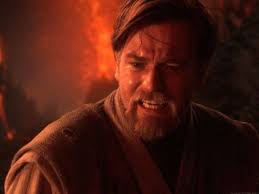 In the same chapter, in one short sentence that probably would have gone completely unnoticed by me (and it actually did the first time I read this book) the narrator casually mentions that Obi-Wan does not believe in predestination. This one line may seem unimportant, until you think about the events of the prequel movies. Obi-Wan trained Anakin, his best friend, to be a Jedi Knight against his better judgement, simply because he was “The Chosen One” who was prophesied to bring balance to the Force. The last thing Obi-wan says to Anakin after his fall to the dark side in Revenge of the Sith is “you were the chosen one! It was said that you would destroy the Sith, not join them! Bring balance to the Force, not leave it in darkness!” Hmm… no wonder Obi-Wan doesn’t believe in predestination after watching his best friend, who was predestined to destroy the Sith, actually join the Sith and destroy the Jedi instead. The prophecy did not come true, and Obi-wan has no way of knowing that it is still to be fulfilled.
In the same chapter, in one short sentence that probably would have gone completely unnoticed by me (and it actually did the first time I read this book) the narrator casually mentions that Obi-Wan does not believe in predestination. This one line may seem unimportant, until you think about the events of the prequel movies. Obi-Wan trained Anakin, his best friend, to be a Jedi Knight against his better judgement, simply because he was “The Chosen One” who was prophesied to bring balance to the Force. The last thing Obi-wan says to Anakin after his fall to the dark side in Revenge of the Sith is “you were the chosen one! It was said that you would destroy the Sith, not join them! Bring balance to the Force, not leave it in darkness!” Hmm… no wonder Obi-Wan doesn’t believe in predestination after watching his best friend, who was predestined to destroy the Sith, actually join the Sith and destroy the Jedi instead. The prophecy did not come true, and Obi-wan has no way of knowing that it is still to be fulfilled.
There is a point in the book where Darth Vader refers to Tatooine as “a miserable outpost world.” That holds a little more weight coming from him knowing that he spent his childhood on the planet as a slave.
An interesting thing is that the book points out that lightsabers cauterize wounds, despite that not happening in the original movie, where Obi-Wan chops off an arm in the cantina and blood is spilled everywhere. In some instances this book is actually more consistent with the rest of the Star Wars universe than the film is.
I could go on and on about why having seen the prequels makes this book more enjoyable, and about the great scenes that go into much deeper detail than the movie does. This book is a treat and reading it actually helps you to understand parts of the movie that you may not have realized you misunderstood before. Alan Dean Foster did a great job with this one, and I enjoyed it thoroughly. I’m excited to go back and re-read his second Star Wars book (and the second Star Wars novel ever written) Splinter of the Mind’s Eye next after having recently finished this one again. This book is very well written, and when you take a moment to realize that this is the first Star Wars book ever written, and that it came out even before the first movie did, you can sort of give it a free pass for the little continuity errors and just sit back and enjoy the novel.
Keeping in mind when this was written, and giving it a free pass on weird stuff, I want to leave you with a short quote from my favorite part of the entire book. Luke just learned from Obi-Wan that his father was Jedi Knight, and he wants to learn more. He decides to ask Obi-Wan a question, and this is how the book describes this little moment:
“How,” he asked slowly, “did my father die?”
Kenobi hesitated, and Luke sensed that the old man had no wish to talk about this particular matter. Unlike Owen Lars, however, Kenobi was unable to take refuge in a comfortable lie.
“He was betrayed and murdered,” Kenobi declared solemnly.
This short section of the book had me bursting out in laughter after I read it, though it was obviously not meant to be funny at the time it was written. Immediately after the narrator tells us that good ol’ honest Obi-Wan is not willing to lie to Luke, Obi-Wan lies to Luke. I couldn’t help but laugh.
If you like A New Hope, and like Star Wars books in general, you’d like this book. But if you’re a huge stickler for 100% accurate continuity, this one might drive you a little crazy. This book has my recommendation though. I’m very glad I decided to pick it up and read it again.
Score: 7.5/10
Oh yeah, and Chewbacca actually gets a medal at the end of this book, along with Luke and Han. Aww.
